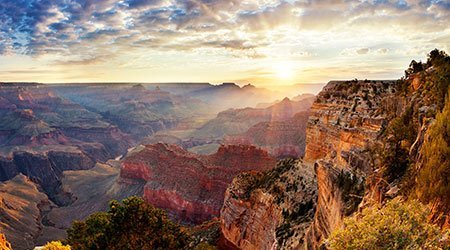Difference Between West & South Rim
The Grand Canyon hosts millions of visitors each year at both its South and West Rims, but many do not realize that these regions rims differ greatly in their unique rock formations and wildlife.
Grand Canyon South

Grand Canyon National Park - also known as the South Rim - is considered the jewel of the American Southwest. Regarded as the Grandest of the Canyons, the South Rim is picturesque from every viewpoint and every angle. Here the ancient rock walls are surrounded by lush forests of Ponderosa pines - which are home to elk, mule deer, mountain lions, rock squirrels, and California condors. The glorious wooded vision of the South Rim has for decades been a favorite of artists and photographers. In fact, it is likely that the South Rim has been the source of nearly every image of the Grand Canyon seen in one's lifetime. Grand Canyon National Park is open year-round for visitors to experience, along with all of its plant life and wild residents.
Grand Canyon West

Just a short distance from the National Park, within the Hualapai Tribal Reservation, is the wild Western nature of the Grand Canyon's West Rim. Though not nearly as commercially-developed as the bustling South Rim, the West still hosts nearly a million visitors each year. Still, this area is much more peaceful and less-crowded. Here the canyon boasts magnificent, naturally-carved rock formations like Eagle Point - a structure revered by the ancient Hualapai. It is also the only region of the canyon where aircraft can access the floor for landings. Most exciting of all is the Skywalk Bridge - the glass walkway that extends out between the canyon walls and allows guests to stare a mile through to the floor. A quick journey from Las Vegas, visit the rugged and serene Grand Canyon West and experience the many unique elements this region has to offer.
South Rim Features
Discover the captivating sight of Ponderosa pine forests sweeping across the rim of the Grand Canyon. With a variety of foliage thriving year-round, this is undoubtedly the most lush region of the canyon.
The South Rim offers the most magnificent views of the canyon. Here the rippling rock walls stretch across the horizon and are nearly 20 miles apart, creating the massive gorge made famous around the world. It is a remarkable and humbling experience to stand amidst this landform millions of years in the making.
Though this behemoth rock structure may appear untouched and uninhabited, it is actually home to elk, mountain lion, squirrels, deer, mule, lizards, and the California condor.
The South Rim is the busiest and most developed area of the canyon. Visitors will find 6 hotels bordering the rim and an additional 5 in the nearby town of Tusayan, Arizona. Also in the area are a multitude of artisanal art and craft shops, visitor information centers, and numerous dining options ranging from casual to upscale.
West Rim Features
The West Rim boasts incredible views atop the world-famous Skywalk Bridge. This remarkable feat of engineering allows guests to walk out into the middle of the canyon, suspended a mile in the air. The bridge's glass floor provides the best view of all: straight down to the canyon floor!
Although the West Rim hosts up to a million visitors annually, it is typically much less crowded compared to the South Rim. Enjoy a more secluded and quiet sightseeing experience here.
While the South Rim is surrounded by dense forests, the West Rim offers a more colorful desert environment. The ambiance here is reminiscent of what the first explorers on the American frontier would have seen.
This region of the canyon has been home to the Hualapai Indian Tribe for centuries. These noble people consider these grounds to be sacred, and are known historically as the "Guardians of the Canyon".